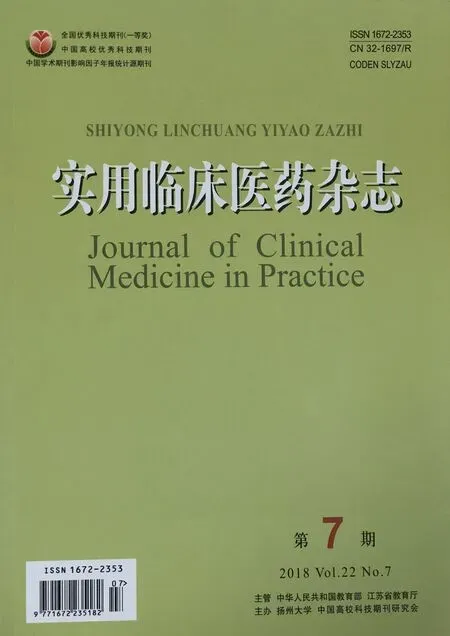抗苗勒管激素在辅助生殖技术中的应用综述
迟令侃, 章晓乐
(上海中医药大学附属曙光医院, 1. 生殖医学中心; 2. 妇产科, 上海, 201203)
苗勒管抑制物质(MIS)又称为抗苗勒管激素(AMH), 是肿瘤坏死因子-β(TGF-β)家族成员之一,在胚胎期AMH与性腺分化有关,是在男性睾丸Sertoli细胞中产生的,主要由于男性生殖器官逐渐形成的过程中发生苗勒氏管退化引起。MIS在女性的早期卵巢中有微量的分泌,主要影响胚胎的苗勒管发育成为女性生殖系统(如子宫、输卵管、阴道),妊娠36周后女性卵巢颗粒细胞成为唯一分泌AMH场所。因AMH 的水平与发育的卵泡数呈一定比例,与年龄的大致对应关系及旁分泌作用,并不参与下丘脑-垂体-性腺轴反馈机制,这也是AMH水平与月经周期几乎无关的原因,能为了解女性生育潜能、预测绝经年龄提供重要参考[1]。本研究主要论述AMH的作用在辅助生殖技术中的应用,现综述如下。
1 AMH与卵泡发育
AMH在卵泡的发育及成熟参中起调控作用,其中包括了始基卵泡和卵泡发育周期的募集作用: ① 减少了原始卵泡损耗从而抑制始基卵泡顺利进入生长阶段; ② 干预了生长卵泡对卵泡刺激素(FSH)的反应,影响了卵泡选择。因生长卵泡的颗粒细胞上表达AMH, 随着窦卵泡继续发育,颗粒细胞上AMH表达量减少。Fanchin等[2]认为AMH与卵母细胞的质量及胚胎的形态有相关性。Lie[3]则持相反意见,认为AMH不能反映卵母细胞质量对人类辅助生殖技术(ART)结局的影响,因血浆AMH与获卵数密切相关,但卵泡液中AMH水平与卵泡质量有关。
2 AMH与卵巢储备
血清AMH可作为评估卵巢储备功能和卵巢的反应性指标,根本上是由卵泡数量和卵泡质量来决定卵巢储备功能的。目前,临床上年龄、窦卵泡数(AFC)、FSH水平、抑制素B、基础雌二醇(E2)水平等均反映卵巢储备功能,但都存在一定的局限性。而由卵泡颗粒细胞分泌的AMH, 因在整个月经周期基本稳定,血清AMH水平不受下丘脑-垂体-卵巢(HPO)轴的影响,较以上指标能够很好地反映“卵泡池”即卵泡数,更好地评估年龄相关的生育能力下降[4]。许多学者[5-7]均认为AMH与AFC相结合,能预测卵巢储备功能,并与获卵数呈正相关。
血浆AMH受获卵数影响较大,多囊卵巢综合征(PCOS)患者卵泡发育阻滞,导致窦卵泡增多无优势卵泡,而AMH由窦前卵泡和小窦状卵泡(D<8 mm)的颗粒细胞分泌,使得AMH水平增高。研究[8]表明过高的AMH可以降低窦卵泡对促卵泡生成素FSH敏感性,进而抑制优势卵泡的选择。Lin YH[9]认为80%的PCOS患者排卵前血清AMH浓度>11 ng/mL, 是健康妇女的2~3倍,可以帮助临床医生行进对PCOS 的筛查。同样,Seow KMy[10]也得出相似的结论。
卵巢早衰(POF)的女性血清AMH水平可与绝经水平相当,低于正常同龄女性。国内一项研究[11]发现卵巢早衰组AMH为(1.57±0.68) pmol/L, 显著低于正常对照组的(6.28±1.50) pmol/L (P<0.05), 其中35例POF中有8例AMH水平低至检测下线。Gracia CR[12]研究认为,AMH作为早期评价卵巢储备降低的理想指标,是因为POF患者的窦前卵泡中AMH表达的是正常,发展到早窦状卵泡期的时候AMH的表达呈下降的趋势,由于原始卵泡耗竭从而导致了越来越少的卵泡进入卵泡生长期,进而血清中的AMH指标降低。Shelling[13]研究认为,因AMH可以维持卵泡池,通过抑制了始基卵泡的募集,从而降低生长卵泡对于FSH的敏感性,进而影响了卵泡周期的募集。因此根据AMH水平了解患者卵巢储备情况,有助于临床医生选用适当的促排卵方案。
3 控制性超排卵技术(COH)过程中AMH变化
卵巢反应性是指在促排卵过程中卵巢对外源性促性腺激素刺激的反应性,主要由卵巢储备功能决定。Riggs R与Jayaprakasan K等[14-15]研究发现, AMH对于预测卵巢反应性高低的AMH界值及其敏感度、特异度等差异较大。Pellatt[16]和Lee JR等[17]的研究均发现过高的AMH抑制卵泡发育,并且Lee JR在COH中发现在促排卵治疗周期中,多卵泡发育使得血清AMH动态变化很明显,血清AMH变化逐渐降低直到hCG注射日,取卵后再逐步增加,因在COH 中小卵泡在卵泡期被募集并发育成熟,使得小窦卵泡的数目减少,血清中AMH降低。有研究显示,在COH过程中,AMH还受血E2浓度的影响,血清E2的浓度在超促排卵过程中会逐渐升高, E2超生理剂量时则会抑制血清AMH的指标水平。Holte A[18]发现非PCOS患者血清AMH水平低,预示卵巢储备不佳,则促排卵效果差,而PCOS患者血清AMH水平低,促排卵效果好。
在关于COH降调节周期的研究中, Jayaprakasan等[19]对比了使用短效GnRH-a降调的患者基础血清AMH值(1.29 μg/L)和降调14 d值(1.55 μg/L)后得出结论,与Penarrubia[20]研究中患者基础血清AMH(4.18 μg/L), 在使用长效GnRH-a降调10 d后血清AMH值(3.51μg/L)与基础水平接近,是因为降调节使基础低水平的血清AMH呈现上升趋势,降调节能使卵泡发育同步化,使即将发育的卵泡池内有合适数量的卵泡,基础血清AMH与降调前、后均值结果也非常接近。因此COH过程AMH是随着卵泡池内卵泡发育动态变化。
3.1 AMH与卵巢低反应
卵巢低反应能预示卵巢功能下降、卵巢衰老。Broer SL[21]对5 707个IVF周期分析发现AMH准确性高于基础AFC及bFSH值,在独立预测卵巢低反应方面。关于对于卵巢低反应界值,国内外均进行相关研究, Arce等[22]对749例的研究提出AMH预测卵巢的低反应界值是12~13 pmol/L。陈子江等[23]通过对1 255个IVF/ICSI周期研究,提出卵巢中的低反应界值水平较Arce更低,为0.893 μg/L, 敏感度为89%, 特异度为58%。叶云[24]认为预测卵巢低反应基础血清AMH 水平界值≤1.795 μg/L。可见AMH对卵巢低反应的预测价值最高。
3.2 AMH与卵巢高反应和卵巢过度刺激综合征
卵巢高反应严重时可能会导致卵巢过度刺激综合征(OHSS),是卵巢对外源性促性腺激素的一种过度反应,目前是治疗周期取消的主要原因。Gn使用量、基础窦卵泡数(AFC)、基础AMH、基础FSH、E2及hCG 注射日AMH水平均与OHSS的发生密切相关。Broer SL[25]认为AMH预测卵巢高反应的敏感度为82%、特异度为76%。为避免OHSS的发生,研究者希望通过检测AMH水平,个体化选取COH方案。Ocal P[26]研究提出,若患者在COH中的Gn启用日,血清AMH>3.3 ng/mL, 61%的概率发生OHSS风险敏感性,特异性为71%。Lee等[27]关于预测卵巢高反应和OHSS的AMH临界值为3.36 μg/L。王馥新研究提出AMH临界值为3.95 ng/mL时,这部分患者可能为高反应者。所以对于AMH相对较高的这部分人群在促排卵过程中应注意Gn用量和方案选择,控制获卵数,提前预防OHSS的发生。
4 AMH与妊娠结局
将AMH应用于预测IVF/ICSI 治疗后妇女的妊娠率国际上一直争议不断。Kaya等[28]提出,对于PCOS, 超促排卵第3天血清AMH水平可以预测患者的受精率、种植率及妊娠率。Arce等[22]一项多中心研究(7个国家25个生殖中心的749例不孕症患者)显示,AMH 与ART周期妊娠率以及活产率呈显著正相关,但其认为AMH相对高水平的患者拥有更多的卵母细胞或囊胚,而非卵母细胞质量高。Nelson等[29]通过回顾性分析340例ART周期发现,活产率与AMH水平呈正相关(AMH≤7.8 pmol/L), 然而当AMH水平>7.8 pmol/L时则无相关性。但也有人反对,如Nelson提出AMH并不能预测妊娠率。一项回顾性研究[30]同样提出血清AMH浓度与年龄负相关,而降低的程度与卵巢储备数量呈正相关,血清AMH是卵巢储备数量(而不是质量)预测的有用指标,与活产率及流产也无关系。Lehmann等[31]研究发现,当血清AMH低于0.47 ng/mL以下时,继续妊娠率显著降低。
总之,随着对AMH的研究不断加深,可以为临床医生提供较好的实验室指标,指导医生为患者制定个体化、安全、合理的促排方案,减少OHSS的发生,改善临床妊娠结局,最终提高辅助生殖成功率,提高患者的满意率。
[1] Lie Fong S, Visser J A, Welt C K, et al. Serum anti-mullerian hormone levels in healthy females: a nomogram ranging from infancy to adulthood[J]. The Journal of clinical endocrinology and metabolism, 2012, 97(12): 4650-4655.
[2] Fanchin R, Mendez L D, Frydman N, et al. Anti-Mtillerian hormone concentrations in the follicular fluid of the preovulatory follicle are predictive of the implantation potential of the ensuing embryo obtained by in vitro fertilization[J]. Clin Endocrinol Metab, 2007, 92: 1796-1802.
[3] Lie F S, Baart E B, Martini E, et al. Anti-Mtillerian hormone: a marker for oocyte quantity, ooeyte quality and embryo quality[J]. Reprod Biomed Online, 2008, 16: 664-670.
[4] Ledger W L. Clinical utility of measurement of aIlti-MulleriaIl hormone in reproductive endocrinology[J]. Clin Endocrineol Metab, 2010, 95: 5144-5154.
[5] 胡蓉. 抗苗勒氏管激素(AMH)预测卵巢储备功能及反应性的研究[J]. 生殖与避孕, 2009, 29(8): 515-519.
[6] Hansen K R, Hodnett G M, Knowlton N, et al. Correlation of ovarian reserve tests with histologically determined primordial follicle number[J]. Fertil Steril, 2011, 95(1): 170-175.
[7] PastuszekE, LukaszukA, Kunicki M, et al. New AMH assay allows rapid point of care measurements of ovarian reserve[J]. Gynecol Endocrinol, 2017, Published online.
[8] Wang J G, Nakhuda G S, Guarnaccia M M, et al. Müllerian inhibiting substance and disrupted folliculogenesis in polycystic ovary syndrome[J]. Am J Obstet Gynecol, 2007, 196(1): 1-5.
[9] Lin Y H, Chiu W C, Wu C H, et al. Anti-Müllerian hormone and polycystic ovary syndrome[J]. Fertil Steril, 2011, 96(1): 230-235.
[10]Seow K M, Wang P H. Anti-Müllerian hormone: a marker for prediction of ovarian function and polycystic ovary syndrome[J]. Chin Medl Assoc, 2012, 75(3): 93-94.
[11]周青雪, 董世雷, 张亚培, 等, 抗苗勒管激素水平在不同卵巢储备功能的女性之间的差异研究[J]. 中国优生与遗传杂志, 2016, 11(24): 115-117.
[12]Gracia C R, Sammel M D, Freeman E, et al. Impact of cancer therapies on ovarian reserve[J]. Fertil Steril, 2012, 97(1): 134-140.
[13]Jayaprakasan K, Campbell B, Hopkisson J, et al. A prospective, comparative analysis of anti-Müllerian hormone, inhibin-B, and three-dimensional ultrasound determinants of ovarian reserve in the prediction of poor response to controlled ovarian stimulation[J]. Fertil Steril, 2010, 93(3): 855-864.
[14]Riggs R, Kimble T, Oehninger S, et al. Anti-Müllerian hormone serum levels predict response to controlled ovarian hyperstimulation but not embryo quality or pregnancy outcome in oocyte donation[J]. Fertil Steril, 2011, 95(1): 410-412.
[15]Jayaprakasan K, Campbell B, Hopkisson J, et al. A prospective, comparative analysis of anti-Müllerian hormone, inhibin-B, and three-dimensional ultrasound determinants of ovarian reserve in the prediction of poor response to controlled ovarian stimulation[J]. Fertil Steril, 2010, 93(3): 855-864.
[16]Pellatt L, Rice S, Mason H. Anti-Müllerian hormone and polycystic ovary syndrome: a mountain too high[J]. Reproduction, 2010, 139 (5): 825-833.
[17]Lee J R, Kim S H, Kim S M, et al. Anti-Mullerian hormone dynamics during controlled ovarian hyperstimulation and optimal timing of measurement for outcome prediction[J]. Hum Reprod, 2010, 25(10): 2597-2604.
[18]Holte A, Brodin T, Berglund L, et al. Antral follicle counts are strongly associated with live-birth rates after assisted reproduction, with superior treatment outcome in women with polycystic ovaries[J]. Fertil Steril, 2011, 96(3): 594-599.
[19]Jayaprakasan K, Campbell B K, Hopkisson J F, et al. Effect of pituitary desensitization on the early growing follicular cohort estimated using anti-Mullerian hormone[J]. Hum Reprod, 2008, 23(11): 2577-2583.
[20]Penarrubia J, Fábregues F, Manau D, et al. Basal and stimulation day 5 anti-Mullerian hormone serum concentrations as predictors of ovarian response and pregnancy in assisted reproductive technology cycles stimulated with gonadotropin-releasing hormone agonistgonadotropin treatment[J]. Hum Reprod, 2005, 20(4): 915-922.
[21]Broer S L, van Disseldorp J, Broeze K A, et al. Added value of ovarian reserve testing on patient characteristics in the prediction of ovarian response and ongoing pregnancy: an individual patient data approach[J]. Hum Reprod Update, 2013, 19(1): 26-36.
[22]Arce J C, La Marca A, Mirner Klein B, et al. Anti-Müllerian hormone in gonadotropin releasing-hormone antagonist cycles: prediction of ovarian response and cumulative treatment outcome in good-prognosis patients[J]. Fertil Steril, 2013, 99(6): 1644-1653.
[23]陈子江. 抗苗勒管激素和抑制素B预测卵巢反应性及ART结局的研究进展[J]. 国际生殖健康/计划生育杂志, 2013, 32(6): 494-497.
[24]叶云, 欧建平, 吴日然, 等. 血清抗苗勒管激素水平预测卵巢储备及在控制性超排卵中的应用[J]. 中山大学学报: 医学科学版, 2010, 31(5): 666-671.
[25]Broer S L, Dólleman M, Opmeer B C, et al. AMH and AFC as predictors of excessive response in controlled ovarian hyperstimulation: a meta-analysis[J]. Hum Reprod Update, 2011, 17(1): 46-54.
[26]Ocal P, Sahmay S, Cetin M, et al. Serum anti-Müllerian hormone and antral follicle count as predictive markers of OHSS in ART cycles[J]. Assist Reprod Genet, 2011, 28(12): 1197-203.
[27]Lee T H, Liu C H, Huang C C, et al. Serum anti-Müllerian hormone and estradiol levels as predictors of ovarian hyperstimulation syndrome in assisted reproduction technology cycles[J]. Hum Reprod, 2008, 23(1): 160-167.
[28]Kaya C, Pabuccu R, Satiroglu H. Serum anti-müllerian hormone concentrations on day 3 of the in vitro fertilization stimulation cycle are predictive of the fertilization, implantation, and pregnancy in polycystic ovary syndrome patients undergoing assisted reproduction[J]. Fertil Steril, 2010, 94(6): 2202-2207.
[29]Nelson S M, Yates R W, Fleming R. Serum anti-Müllerian hormone and FSH: prediction of live birth and extremes of response in stimulated cycles --implications for individualization of therapy[J]. Hum Reprod, 2007, 22(9): 2414-2421.
[30]Tremellen K, Kolo M. Serrum anti-Mullerian hormone is a useful measure of quantitative ovarian reserve but does not predict the chances of live-birth pregnancy[J]. Aust NZJ Obstet Gynaecol, 2010, 50: 568-572.
[31]Lehmann L, Del P M, Saumet J, et al. Anti-Müllerian hormone: a reliable biomarker of oocytes quality in stimulated in vitro fertilization[J]. Fertil Steril, 2012, 98(3): S11-S16.
- 实用临床医药杂志的其它文章
- 小儿腹腔镜和传统睾丸下降固定术的疗效比较
- 肢端肥大症的治疗进展

